Essential Tips for Tying a Saree: A Guide for Indian Crossdressers
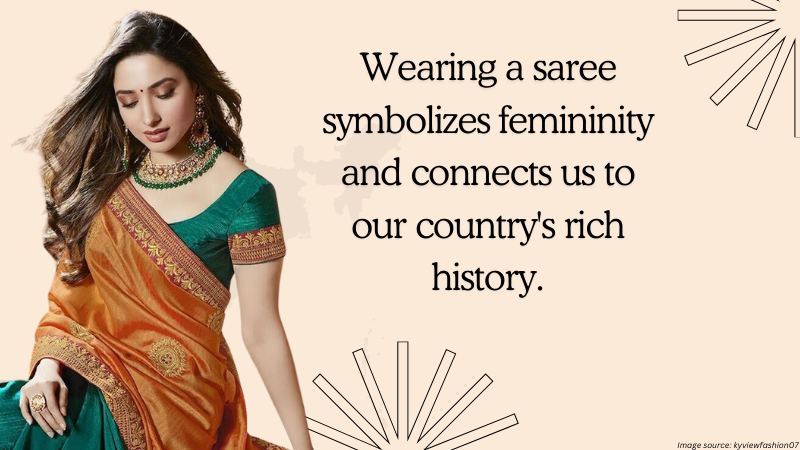
As Indian crossdressers, we have outfits and fashion that are unique and different. Sarees are valuable to us beyond their aesthetic appeal. Wearing a saree symbolizes femininity and connects us to our country’s rich history. This makes it popular with Indian women. Thus, we must know how to tie sarees to wear them comfortably. This article gives us crucial saree-trying tips and emphasizes our necessity. It also describes Indian saree components and types. The article will explain how to wear a saree and style it.
Importance of mastering the saree for crossdressers
Crossdressing as Indians means that we have to learn how to wear a saree, which will enhance our beauty and identity.
Crossdressers should know sarees for these reasons:
Sarees are art

Sarees are traditionally worn by most women of India on special occasions.
To us, sarees are not just garments but are considered much more than that.
Therefore, sarees represent identity, style, and grace for us as crossdressers.
We can use them to raise our voices.
It is through sarees that we may speak and make others recognize us based on our unique identity.
Culture Connection
Through saree, we get to engage in the life activities of Indians and feel that we belong to the society as India’s crossdressers.
We can live life like any other citizen without having dysphoria.
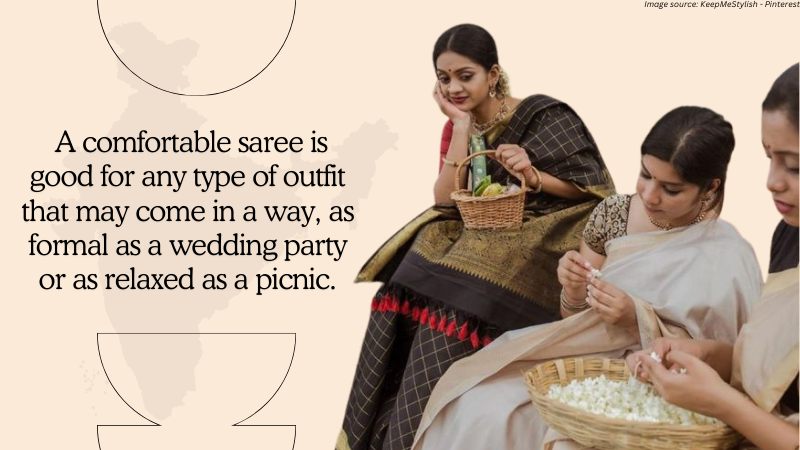
A comfortable saree is good for any type of outfit that may come in a way, as formal as a wedding party or as relaxed as a picnic.
Wearing a saree ensures that we are well dressed and auspicious at work or on any formal occasion.
Femininity Attitude
We wear sarees mostly during occasions such as wedding ceremonial functions and other special activities.
Hence, with saree we can show our gender identity and our feminine nature without judgment and discrimination.
Also, we are more confident of who we are when we wear saree as they not only represent decent attire but also represent our image as crossdressers.
The Components of an Indian Saree
As crossdressers, we need to master the components of an Indian saree to make us wear the garment in the correct form.
Here are the components of an Indian Saree:
Saree
A strip of cloth many times extending from five to nine yards in length and two to four feet in width and more often sowed or stitched only at the edges.
This component covers most parts of our bodies, compared to other components.
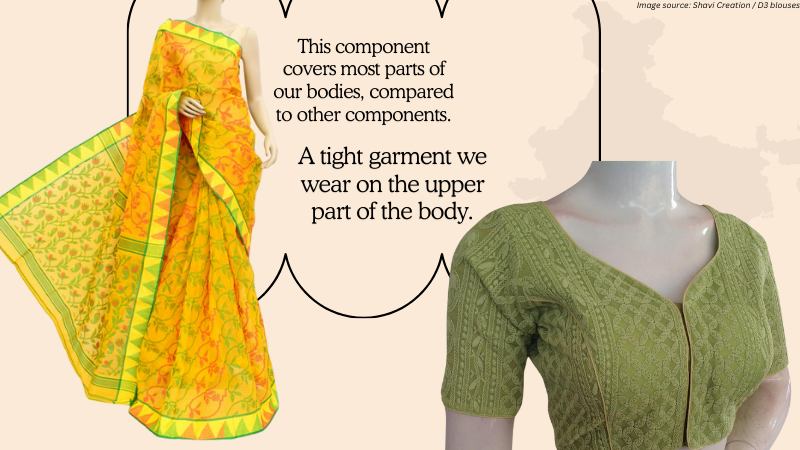
Blouse
A tight garment we wear on the upper part of the body.
Blouses may have short, long, or no sleeves at all; generally, they are cropped to accommodate a midriff.
Petticoat
This is a long undergarment that we can wear under the saree to tuck the saree material into.
It should ideally be the same color as the saree or be colorless so that it does not affect the color of the saree.
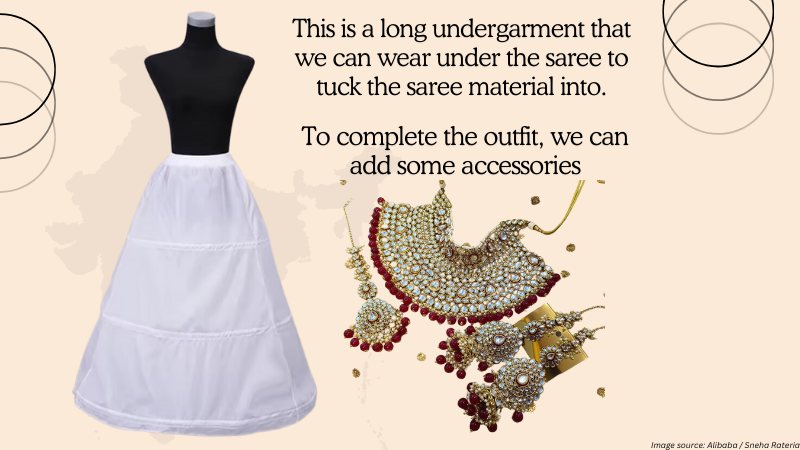
Accessories
To complete the outfit, we can add some accessories.
For instance, stones or beads, jewelry, bindis and other accessories go well with a saree to complete the look.
Different Types of Sarees
Sarees come in different types based on the fabric used and the occasion we wear these attires.
These types include:
Banarasi Saree
These sarees are from Varanasi.
We know them by their pure silk body and, more often, ornate brocade and jute work with gold and silver zari.
These sarees also have motifs and unique patterns that symbolize our cultural values and traditions.
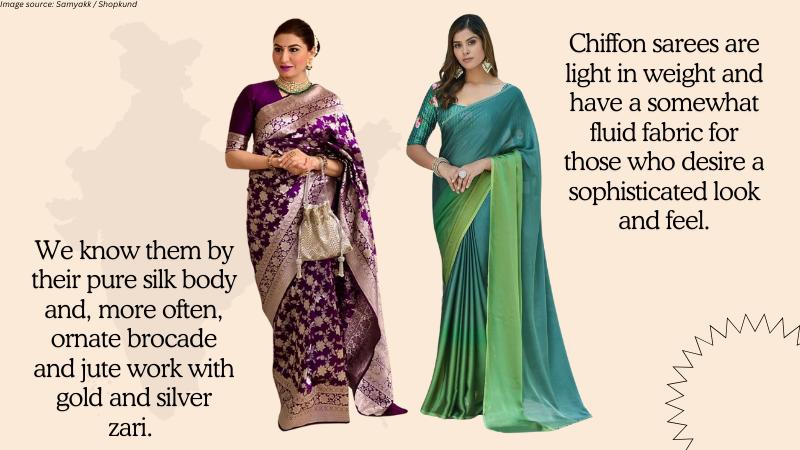
Chiffon Saree
Chiffon sarees are light in weight and have a somewhat fluid fabric for those who desire a sophisticated look and feel.
The saree is adorned chiefly with embroidery or print.
Remember, we can wear this type of saree while performing everyday tasks.
Georgette Saree
Georgette sarees are a versatile fabric. They are light and semi-transparent.
They can be easily paired with many other accessories.
Depending on our preferences, we can wear this type of saree for various occasions, such as family gatherings, weddings, and festivals.
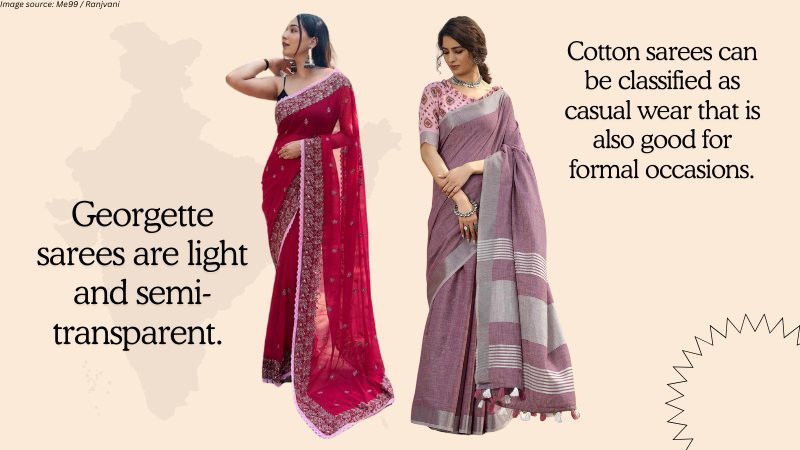
Cotton Saree
Cotton sarees are lightweight and very versatile.
We can classify them as casual wear that is also good for formal occasions.
Their designs are plain but elegant. Most of us wear cotton sarees during summer.
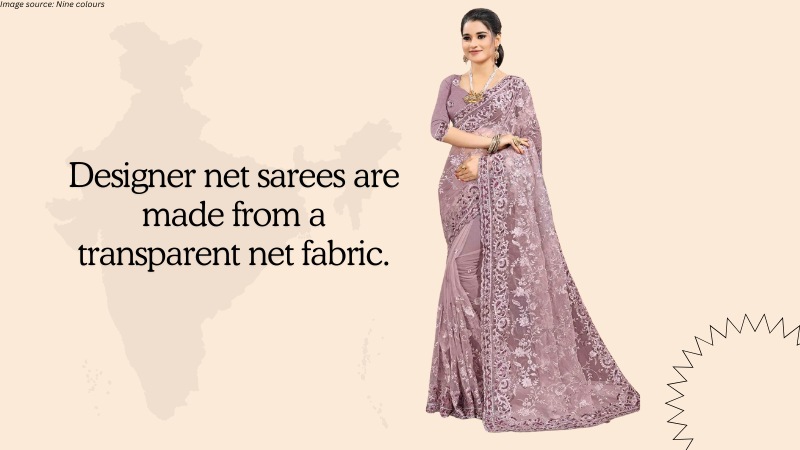
Designer Net Saree
These sarees are made from a transparent net fabric.
They use zari work, sequins, and stones.
These decorations make them better for festivals.
I would wear this type of saree to a wedding because of its elegant nature.
Step-by-Step Guide to Tying a Saree
A saree is different from a type of outfit that we can wear swiftly as it has several steps that we should follow to acquire the look we desire.
Here are the steps guide to tying a saree:
Prepare the Base
First, we can put on the blouse and the petticoat.
The petticoat has to be tied right across the belt area since it will weigh the saree.
We should ensure that the end of the petticoat is slightly below our ankles.
Tuck the Saree
The second step involves tucking the saree.
We can wear it starting with the blunt end, which is spread over the shoulder on the left from the bust line downwards.
Also, bring the top end of the saree up to the navel and twist once around the waist, with the bottom pointing to the floor with the petticoat.
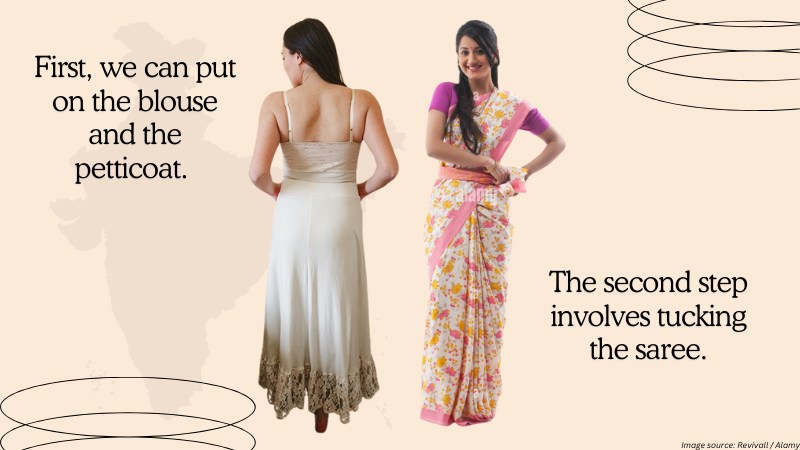
Create Pleats
The third step after tucking the saree involves making pleats.
For example, after one complete turn, start making the pleats.
Still, keep the fabric divided about five inches from the end.
Then, begin pleating by folding it back on itself.
Make the pleats roughly five inches wide.
We would need to fold it about five to seven times depending on the width of the saree we intend to wear or what we desire.
Tuck the Pleats
The fourth step involves tucking the pleats.
We can achieve this by bringing all the pleats to the central line and ensuring they are the same length.
We also need to arrange them in the petticoat to the left of our navel so that they face the left direction.
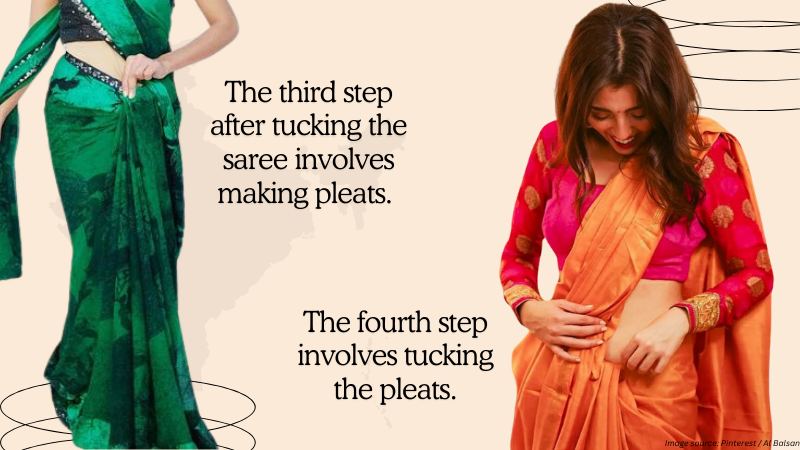
Drape the Pallu
We can fold the rest of the fabric, called the pallu, and bring it back over the shoulder.
Now, fold the other end, which was hanging in front of the thigh, toward our waist.
Try to tuck it around our tummy.
Then, cross it over the burst area and place the end of the saree over the left shoulder.
Tuck the pallu to the sides and ensure it is long enough to fall gently at the back of the wearer.
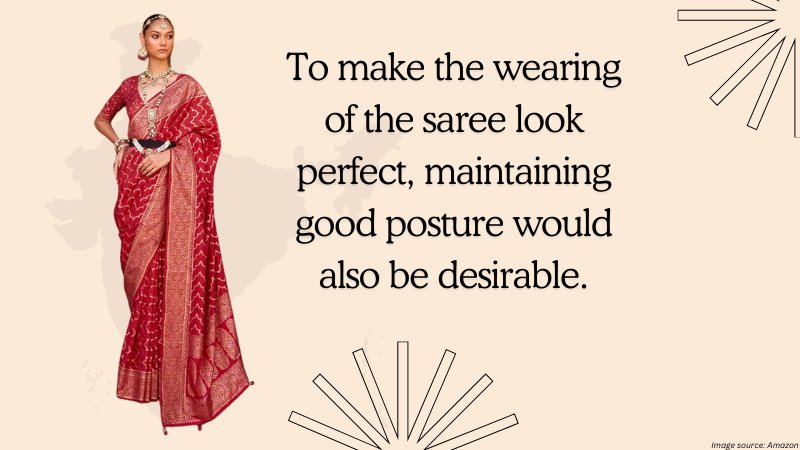
Secure the Pallu
This step depends on our preference and how we would like to style it.
For instance, the pallu may be left somewhat open, which is the typical style.
It may also be pinned, which causes the pallu to have a neater appearance.
When pleating the pallu, we should fold it towards us, then fold it regularly in folds.
Then, with the help of pins, pin the corner of the pallu to the blouse at the shoulder portion.
Final Adjustments
Look for the end of the saree cloths and ensure they are well-fit and tidy or do not have jagged tucks.
Tuck in or make proper folds of the pleats and pallu before appropriately draping them.
Ensure that the length of the saree is correct; that is, the bottom end of the saree is touching the floor.
Styling Tips
As crossdressers, we should also remember the styling tips of sarees to be unique among the crowd.
Some styling tips include:
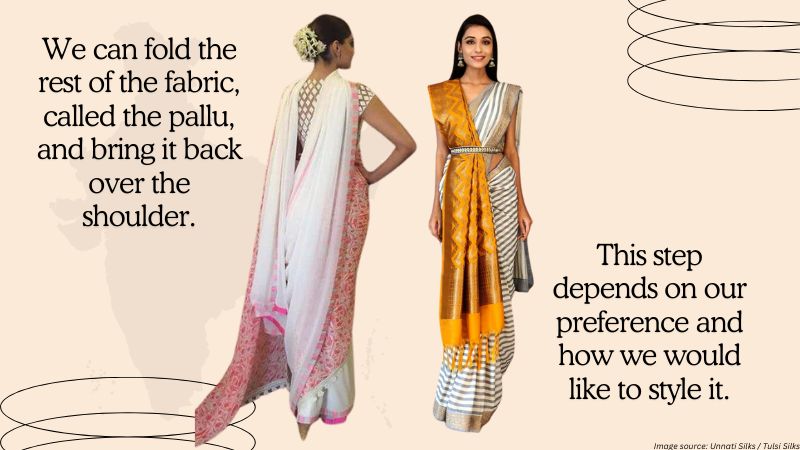
Choose the Right Footwear
We should choose footwear that goes well with the saree and makes us comfortable.
For instance, heels will give us a few more inches and improve our appearance.
Accessorize
The outfit may be extraordinary and unique, with accessories that go well with our saree.
However, we should choose and wear accessories depending on the event and the design of the saree.
For instance, necklaces, bangles, earrings, and bindis can go a long way in giving that glamorous feel.

Hairstyle
As crossdressers, hairstyle is equally important as choosing the best type of saree.
We can go for traditional themes like buns, braids, or loose curls.
We may also add flowers to our hair or use decorative pins to glam things up.
Makeup
We can use makeup to highlight our saree and, at the same time, accentuate our face.
While doing so, we should not exaggerate the makeup we put on.
For instance, red lips, smooth eye makeup and bindi can give us a conventional look.

Posture and Confidence
The outfit becomes more appealing depending on how we wear it and our confidence.
The taller and more dignified we look, the more we are to walk and the more confidence we may show.
To make the wearing of the saree look perfect, maintaining good posture would also be desirable.
Conclusion
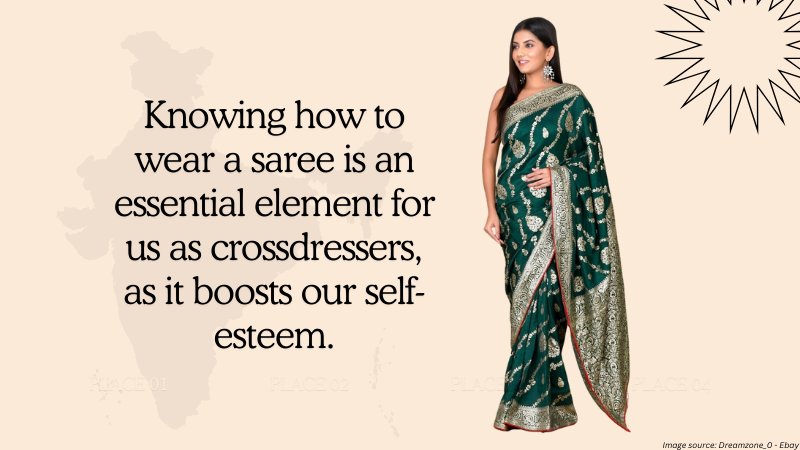
The saree is a powerful outfit that enables us to display our culture, traditions, and gender identity.
Knowing how to wear a saree is an essential element for us as crossdressers, as it boosts our self-esteem.
Therefore, we need to learn the components of sarees and their different types.
We should also be familiar with the steps guide for tying sarees and the various styling tips.
Most importantly, we Indian crossdressers should be proud. We should be confident in our gender.
We should embrace it through modern styles.
- 7 Best Crossdresser Sleepwear Styles for Comfort and Femininity
- Color Guide for Crossdressers: Tips to Create Perfect Outfits
- Mastering the Bunny Suit Look: A Crossdresser’s Style Guide
- Latex Crossdresser Fashion: A Sharp Tool for Deep Feminine Exploration
- Pride Parade 101: What to Wear and How to Shine in Your Pride Outfit
- How to Safely Wear a Sissy Maid Outfit in Public? Tips for Crossdressers and Sissies
Established in 2009, We are a recognized manufacturer and seller of professional crossdressing products.
It is our aim to become not just the most creative manufacturer but also a very considerate seller, as we provide the best quality products for crossdressers all around the world.






















 Breast Forms
Breast Forms  Body Suit
Body Suit  Realistic Mask
Realistic Mask  Femini Girdle
Femini Girdle Hip & Butt Enhancement (8)
Hip & Butt Enhancement (8) Penis Prosthesis
Penis Prosthesis Fake Muscle
Fake Muscle Bikini
Bikini  Wig
Wig  Corsets
Corsets Course
Course service@roanyer.com
service@roanyer.com +8618652200711
+8618652200711 Facebook
Facebook YouTube
YouTube Twitter
Twitter Instagram
Instagram




